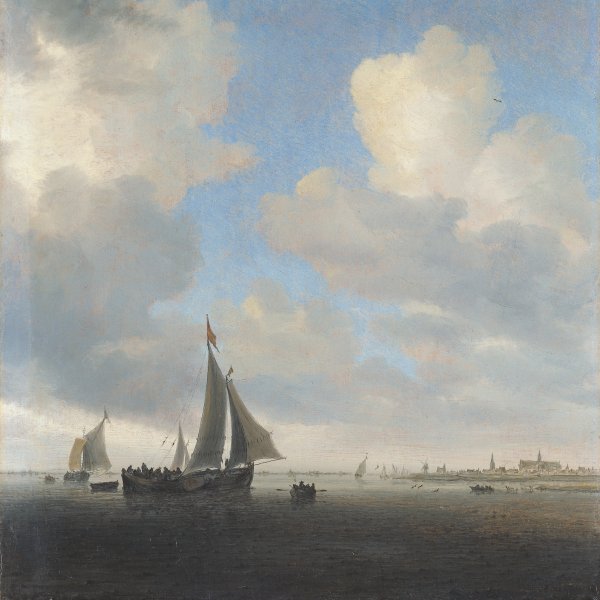The Old Fish Market on the Dam, Amsterdam
ca. 1650
Oil on panel.
55 x 44.8 cm
Museo Nacional Thyssen-Bornemisza, Madrid
Inv. no.
438
(1930.127
)
ROOM 25
Level 2
Permanent Collection
According to Houbraken, Emmanuel de Witte first trained with the Delft still life painter Evert van Aelst. He is documented in the painters’ guild in that city in 1636. He is later documented in Rotterdam in July 1639 and was once again in Delft in 1641. By 1652 he was in Amsterdam where he settled for the remainder of his career. De Witte was particularly esteemed for his paintings of church interiors but also depicted other subjects including a series of oils of market scenes whose precedents lie in the works of Pieter Aertsen and Joachim Beuckelaer.
Among his market scenes the present example is the earliest and was dated by Manke to around 1650. De Witte depicts a central aisle in the market framed by the stalls on either sides with fish and with customers holdings their baskets. The artist focused on the light in the first room, which is followed by another that is visible through a semicircular archway. This second area is more dimly lit and includes a large number of figures. The painting has become darker over the course of time, which makes it particularly difficult to read the right-hand side of the composition.
De Witte uses the colours and lighting to draw the viewer’s attention to the scene that takes place on the left where a woman in a white bonnet leans towards the stallholder so that he can place her purchase in her basket. Standing next to and on the same level as the huge fish on the stand (which include two skate) is a little girl seen from behind, while in the centre foreground a hungry dog observes the scene closely. We also see a stork, a motif that De Witte included in later market scenes. The bird holds a fish in its beak that it has found on the floor.
The scene is an accurate depiction of the old fish market in Amsterdam, which was located in the southwest corner of the city according to Balthasar Florisz. van Berckenrode’s map published in 1625. The market was completely surrounded by houses, as can be seen in this panel. Other similar compositions of fish markets by De Witte date to the early 1660s and to the 1670s. They depict larger spaces and include partial views of the city or backgrounds with a port, and have fewer figures of a more volumetric type. This is the case with the painting in the National Gallery in London and the one of 1672 in the Boijmans-Van Beuningen Museum in Rotterdam in which the fish is depicted in the foreground next to three figures.
The provenance of this panel is known from the 18th century when it was auctioned in Amsterdam in 1783. It belonged to the Dukes of Sutherland for some generations and was acquired for the Thyssen-Bornemisza collection via the Sanct Lucas gallery in Vienna in 1928.
Mar Borobia
Among his market scenes the present example is the earliest and was dated by Manke to around 1650. De Witte depicts a central aisle in the market framed by the stalls on either sides with fish and with customers holdings their baskets. The artist focused on the light in the first room, which is followed by another that is visible through a semicircular archway. This second area is more dimly lit and includes a large number of figures. The painting has become darker over the course of time, which makes it particularly difficult to read the right-hand side of the composition.
De Witte uses the colours and lighting to draw the viewer’s attention to the scene that takes place on the left where a woman in a white bonnet leans towards the stallholder so that he can place her purchase in her basket. Standing next to and on the same level as the huge fish on the stand (which include two skate) is a little girl seen from behind, while in the centre foreground a hungry dog observes the scene closely. We also see a stork, a motif that De Witte included in later market scenes. The bird holds a fish in its beak that it has found on the floor.
The scene is an accurate depiction of the old fish market in Amsterdam, which was located in the southwest corner of the city according to Balthasar Florisz. van Berckenrode’s map published in 1625. The market was completely surrounded by houses, as can be seen in this panel. Other similar compositions of fish markets by De Witte date to the early 1660s and to the 1670s. They depict larger spaces and include partial views of the city or backgrounds with a port, and have fewer figures of a more volumetric type. This is the case with the painting in the National Gallery in London and the one of 1672 in the Boijmans-Van Beuningen Museum in Rotterdam in which the fish is depicted in the foreground next to three figures.
The provenance of this panel is known from the 18th century when it was auctioned in Amsterdam in 1783. It belonged to the Dukes of Sutherland for some generations and was acquired for the Thyssen-Bornemisza collection via the Sanct Lucas gallery in Vienna in 1928.
Mar Borobia










